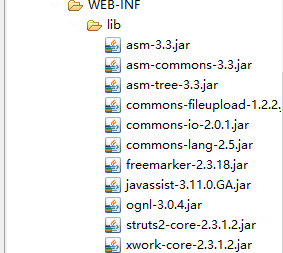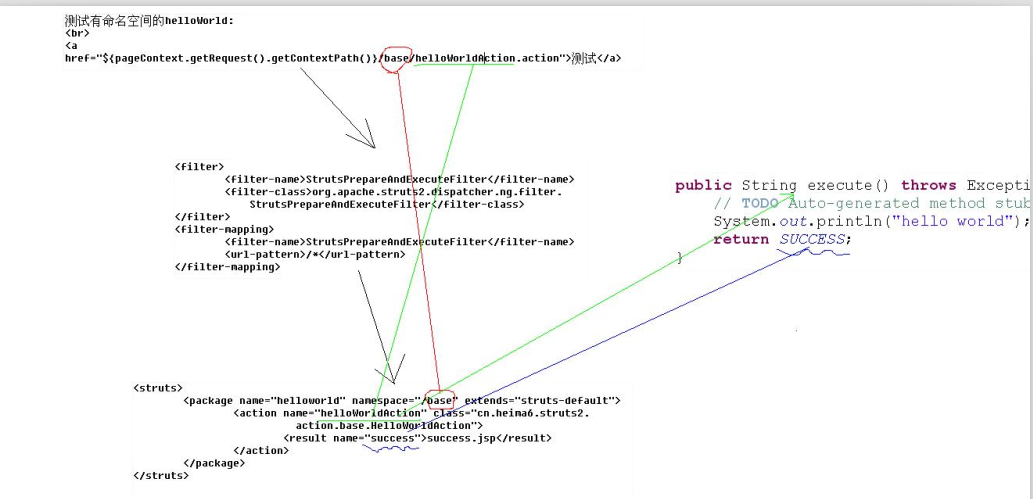一、配置过程
1.在web.xml中配置过滤器
<filter> <filter-name>StrutsPrepareAndExecuteFilter</filter-name> <filter-class>org.apache.struts2.dispatcher.ng.filter.StrutsPrepareAndExecuteFilter</filter-class> </filter> <filter-mapping> <filter-name>StrutsPrepareAndExecuteFilter</filter-name> <url-pattern>/*</url-pattern>
2.导入struts2框架包

3.在src目录下创建struts.xml(必须在src下创建)
文件开头(dtd文件版本跟导入的struts2的基本一致)
<?xml version="1.0" encoding="UTF-8"?> <!DOCTYPE struts PUBLIC "-//Apache Software Foundation//DTD Struts Configuration 2.3//EN" "http://struts.apache.org/dtds/struts-2.3.dtd">
4.在Preference中添加struts-2.3文件,并加入key值,key值为struts.xml文件开头“
-//Apache Software Foundation//DTD Struts Configuration 2.3//EN
”

二、struts2基本流程
1.请求
测试有命名空间的hello world:<br>
<a href="${pageContext.request.contextPath}/base/HelloWorldAction.action">有命名空间</a><br>
测试没有命名空间的hello world:<br>
<a href="${pageContext.request.contextPath }/HelloWorldAction.action">没有命名空间</a><br>
请求对应图

2.通过web.xml文件进行过滤,跳转至struts.xml配置文件中
3.struts.xml配置文件和action的代码为:
<?xml version="1.0" encoding="UTF-8"?> <!DOCTYPE struts PUBLIC "-//Apache Software Foundation//DTD Struts Configuration 2.3//EN" "http://struts.apache.org/dtds/struts-2.3.dtd"> <!-- 导入dtd文件 --> <struts> <!-- package 1.为包,能方便进行action管理 2.属性 name: 代表包的名称 主要用于继承 name的名称是唯一的 namespace: 命名空间 在客户端访问action时使用,也就是说在url中使用 如果没有命名空间 http://localhost:8080/struts2/a.action http://localhost:8080/struts2/b.action 上面写的url没有模块的概念,但是如果有命名空间,就有模块的概念 如果namespace有值,则在result中,会把命名空间加入到响应的路径中,如果是重定向,那么就会重定向到该命名空间下的action extends 配置文件中的继承 --> <package name="helloworld" namespace="/base" extends="struts-default"> <action name="HelloWorldAction" class="com.struts2.action.HelloWorldAction"> <!-- result struts2会根据result进行转发或者重定向 属性 name 为result名称 属性的值和action中execute方法的返回值一致 如果不写name属性,则会默认为name的值为success type 代表返回方式 选择重定向还是转发,还可以重定向到action 如果type没有设定,则为默认值。这个默认值可以从struts-default.xml中得出结论 <result-type name="dispatcher" class="org.apache.struts2.dispatcher.ServletDispatcherResult" default="true"/> --> <result>success.jsp</result> </action> </package> </struts>
package com.struts2.action;
import com.opensymphony.xwork2.Action;
public class HelloWorldAction implements Action {
public String execute() throws Exception {
System.out.println("Hello World");
return SUCCESS;
}
}
会寻找与请求对应的action,并在result中做出相对应的反馈,取得反馈的值后会经过两个struts2中的2个框架类进行转发(内部也是servlet),最后跳转到相应的页面
总流程为:
